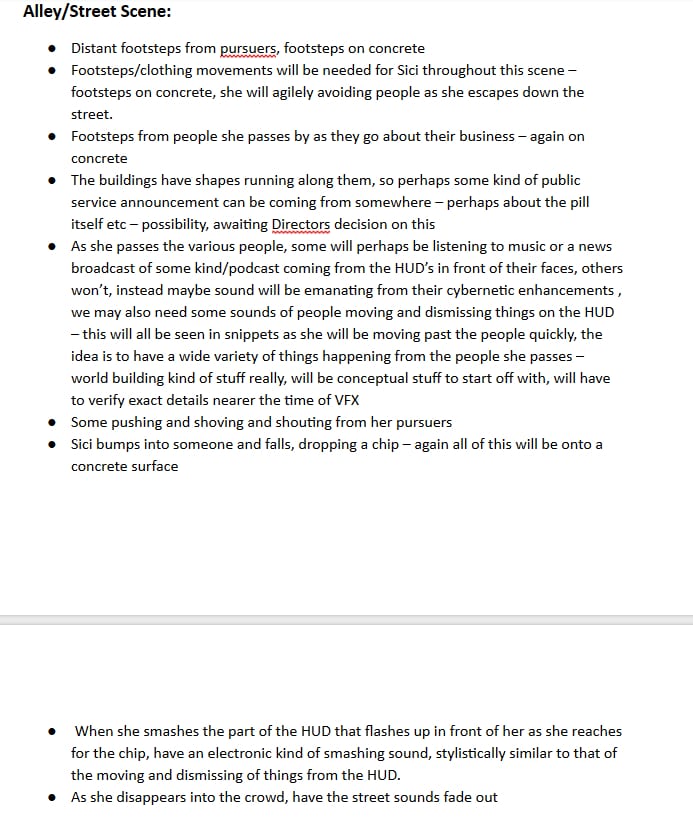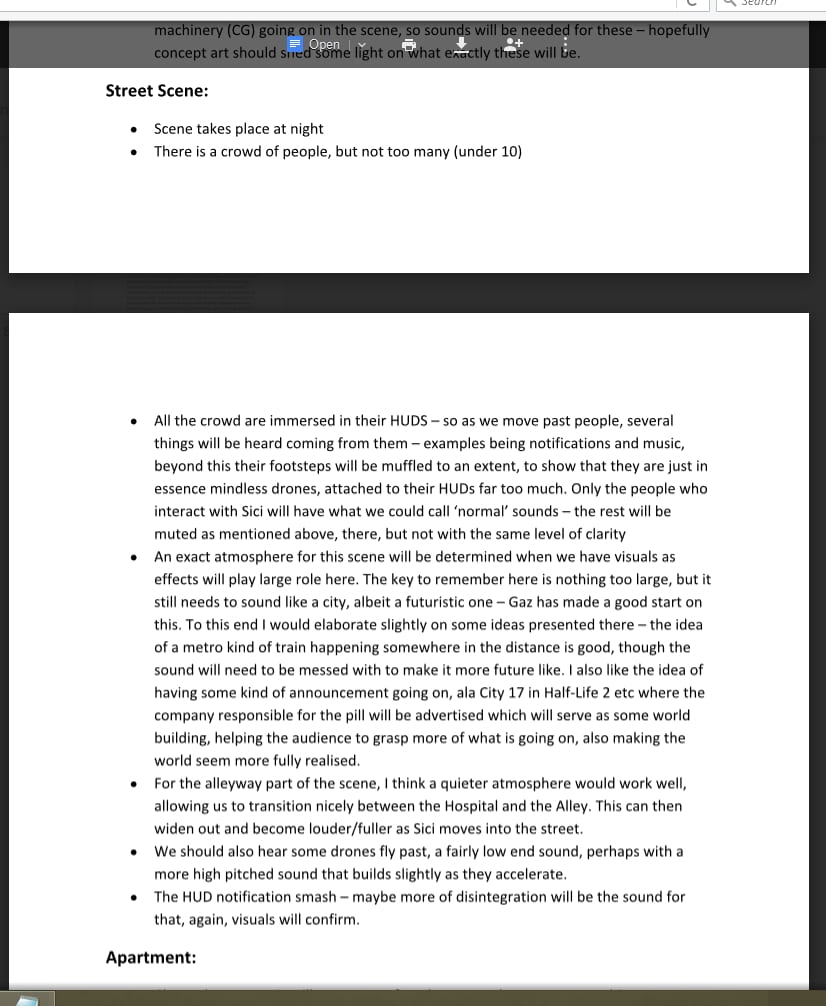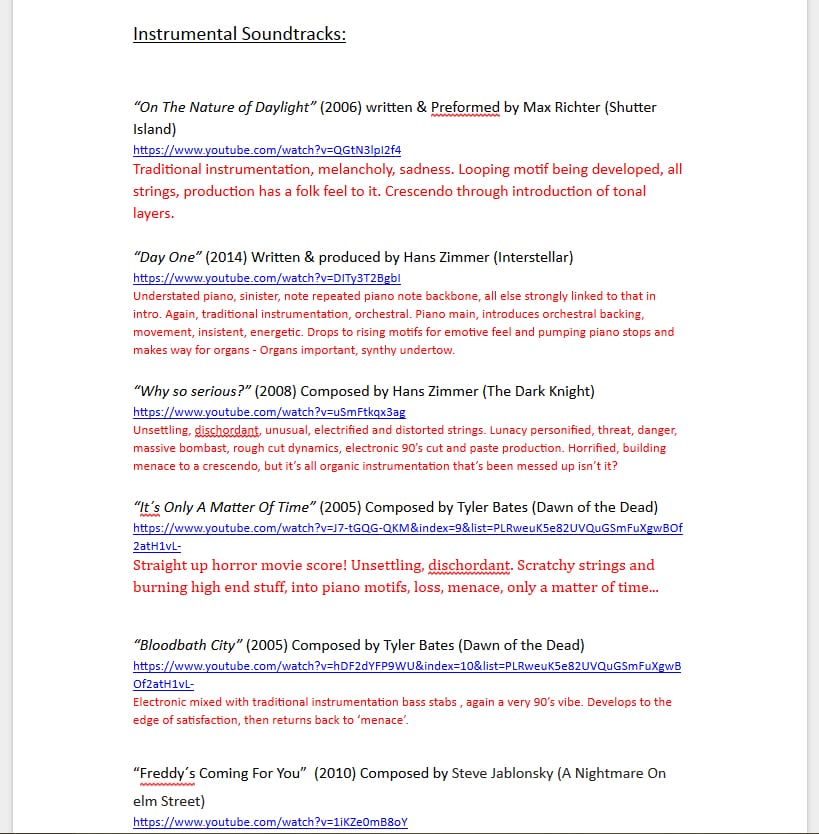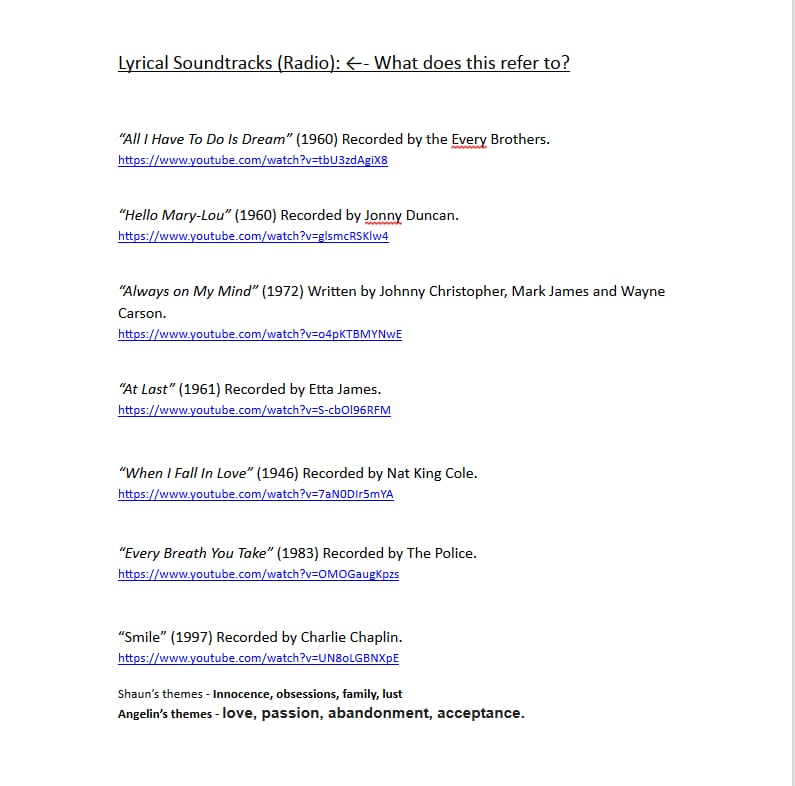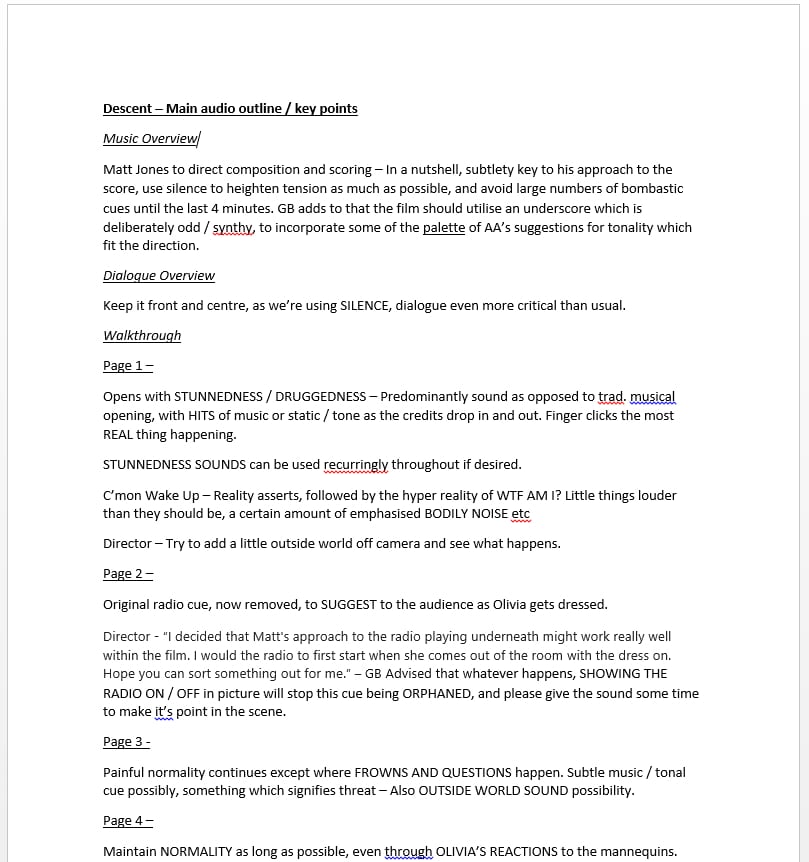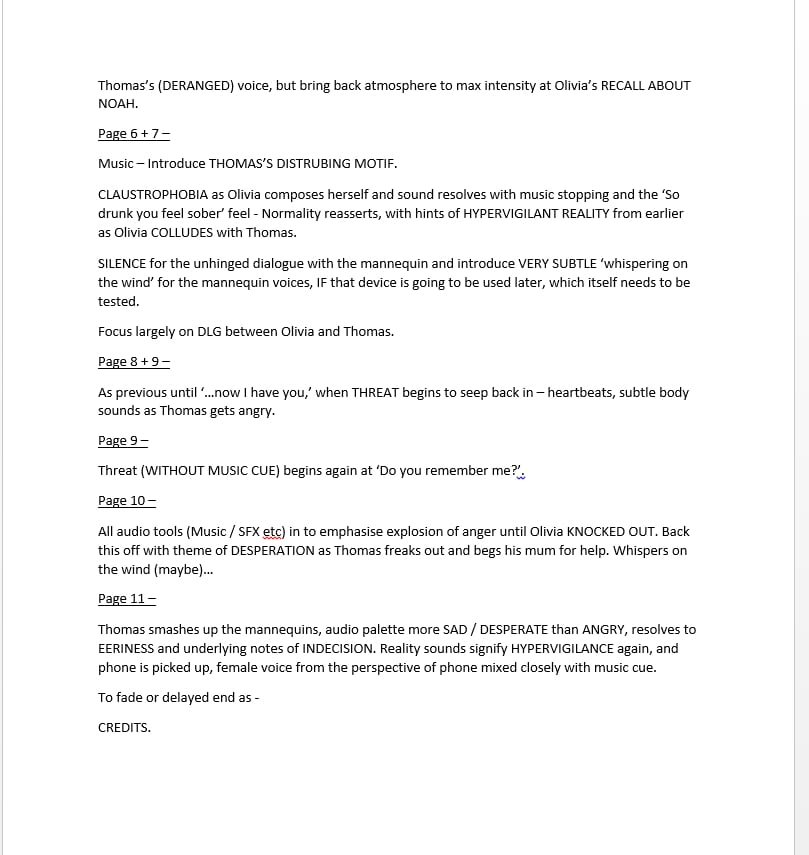Screen caps of the early and later versions of the sound design plan for Immort.
P + P – Progress Report – March
(Outcomes – GR1, 2, 3, 4 + IN1 + PER4)
With completion of our final shooting day on Thursday 24th March, production has now wrapped on all of the five films we’re working on, and even with two shoots substantially over-running their initial dates and requiring numerous reshoots we are currently on track for picture-locks for all of the films more or less on time – all of them are scheduled for today, basically. We have also made inroads into some substantial aspects of post production for three of the films over the last few weeks, mainly due to a policy of consistently badgering editors for work in progress cuts of the work which have enabled the members of the team not tied up with location work to make a head start on post-production. The team have also been extremely effectively covering one another for location work, with boom ops and supervisors operating interchangably based on who’s available on any given day. [GR1,2,3]
Amusingly, in terms of our expectations vs the reality of production, the most outwardly-organised group of film-makers with the most ambitious ideas in pre-production have ended up being the most heavily behind schedule, whilst the production team with whom we had a horrendously complex experience last semester that caused their project to overrun by some months (and from whom we half-expected issues this term) ran an extremely efficient shoot which completed without need to recourse to their contingency day and without any significant issues whatsoever. [IN1]
Composition is as good as complete for one picture and underway for two others, with work in progress scratch-tracks having been demoed to the relevant supervisors and the rest of the team for feedback purposes in all those cases. Supervisors have remained in close contact with both directors and editors (in some cases these are the same person) for the films they’re managing, and we are now beginning a process of adapting the initial audio plans for our films to the reality of the pictures as they arrive. [GR1,2]
The sci-fi leaning films are the best examples of this process. Since it is extremely difficult to realise a convincing sci-fi vision with little experience or budget, the two films with sci-fi themes have tended to underplay the futuristic elements visually a little. This leaves more room for the audio to do the work of signifying and world-building, but also requires a deft directorial stance not to allow the audio to undermine the visuals where these haven’t quite matched the director’s initial vision. The picture must always dictate the audio and even if the director’s original vision for a scene was much more interesting from a sound design perspective it’s necessary to rein in the largesse at times. [GR4]
In terms of my own contribution, I’ve been on-set for three of the five films including managing the entire location audio operation and subsequent transfers and admin for Descent, have contributed considerably to sound design and foley aspects of Immort and Feel Good, such as they are completed at the moment. As we’ve got into the momentum of production with the crews, administrative requirements for the project have thankfully slackened off somewhat. [PER4]
My hours spent on the project for March have broken down roughly as follows, not including academic aspects such as blogs or research –
March Total = 101
Admin – 16
Meets – 7
Location – 52
Creative Work – 24.5
Other – 1.5
Our main issue this month has been facilities, as mooted in February’s report. In order to alleviate the pressure on our favoured workspace our institution took the insane decision to cancel 12 of our 38 booked sessions and drastically shorten another 8. This destroyed our post-production schedule at a stroke, and created a veritable storm of admin in planning and rebooking work. We tried to rationalise this into real world terms as if some kind of technical catastrophe had befallen the facility, but practically we have lost any hint of a margin for error on the part of any of the films and experienced another ballooning of administrative time for the project as a consequence. [GR1,2]
The main impact of this complication in terms of the team was morale, since most of us were flat-out on set with little time to think about the ramifications or spend time replanning our post work for the films. As the situation here is now somewhat fluid (it is impossible to say whether the Sound Theatre will actually be available to use for two days of each week until we get to the day), we are setting our work priorities on a week by week basis, with desired outcomes for each film set at the production meeting at the beginning of said week. We’re confident we can manage the films as long as they remain on schedule which, at the present time, largely appears likely.
In the interest of staying ahead of the game the priority for each supervisor going forward is now to decide who will be performing the final mixing of each of their films and where this person will be performing said mix, and then setting a deadline for it’s completion, the latter preferably in confluence with the director of their film. Aside from the benefit of a solid deadline, this will enable a process of centralisation of the data from aspects of audio production for each film which is now being split across multiple people in different environments (our composers are tending to work at home, for example) which will hopefully avoid too many data management and compatibility issues as the aspects of the films come together. [GR1, 2]
——————————————– 950 words
KEY POINTS –
Overview of situation generally for the project and specifically for the film Descent –Professional practice, Process Management.
- [GR1] To professionally operate as a small to medium size company (or other recognisable business entity) in the audio production / post-production field might.
- [GR2] To organise and fulfil an operating strategy and schedule which deals with multiple productions simultaneously, and which maximises efficiency and minimises issues or risks to delivery.
- [IN1] To successfully manage the provision of service by the business for the film Descent with regard the assignment of resources, specialisms and working time, liason with the director, editor and producer on a practical and creative level, and communication of information on their needs and requirements for the piece, in order to appraise the efficacy of the collaborative approach to working on the piece – (Supervisor and Company Officer)
Breakdown of work carried out in March – Contribution
- [GR3] To provide a professional standard of service in respect to location sound recording and post-sound design / mixing.
- [GR4] To conceive, compose, source and / or produce music to client specifications that synergistically supports the other components of their films.
Collective creative process – Process Management
- [GR1] To professionally operate as a small to medium size company (or other recognisable business entity) in the audio production / post-production field might.
- [GR2] To organise and fulfil an operating strategy and schedule which deals with multiple productions simultaneously, and which maximises efficiency and minimises issues or risks to delivery.
Contribution specifics – Contribution
- [PER4] To contribute extensively to multiple film productions.
Reflection on process of adapting audio plans and outcome of facilities issues– Individual reflection on learning and team role
SUPPORTING MATERIAL – ‘Descent’ Original Reference Material
SUPPORTING MATERIAL – Descent Sound Plan
RESEARCH – Dubbing Mixer
(Outcomes – IN1,2,3 + PER3 + GR5]
“…dubbing is the Cinderella art of film-making, it’s all but invisible to the general public yet the final responsibility for the sound of Prince Charming’s approaching footstep rest firmly with Cinders rather than with the Ugly Sisters of picture or sound editing.“ – (msteer.co.uk)
Even though my group are collectively handling a number of films and may not strictly enact a given role on all of them, group members have each chosen an industry specialism to enable our research. In my case, this is the role of the Rerecording or Dub Mixer.
The term ‘dub mixer’ originally evolves from the early days of celluloid and audio tape editing, abbreviated either from the process of ‘doubling’ reels of audio to sync them with film images or from the process of rerecording actors voice in sync with their dialogue on screen (I recall Betamax home video recorders with an ‘Audio Dub’ button that enabled the user to replace the soundtrack of a given tape), the latter of which was once referred to as ‘dubbing’ but has now been redefined as Additional Dialogue Replacement or ADR. The same term became ubiquitious for any tape to tape rerecording process as time passed prior to the advent of digital, but has tended to be referred to as a Rerecording Mixer in more recent times.
“They are primarily responsible for ensuring that film sound is correct both technically and stylistically.“ – (media-match.com)
The dub mixer’s process requires the bringing together of all the audio ‘elements’ (dialogue, automated dialogue replacement, foley, sound effects, atmospheres, and music) of a given film, and the creation from these of a final audio soundtrack, as well as any other mixes required by the client for other purposes such as the music and effects components often required to enable distribution to other territories. This means a dub mixer is responsible for creating the best representation of the film’s audio aesthetic whilst maintaining both the most potent dramatic impact and the correct technical specifications for it’s intended distribution and / or audience. [IN2]
Dub mixing is fundamentally a final stage process which means it is often one performed under the tightest pressure both in terms of time and, potentially, financially. Graham Hartstone, who has an impressive 60+ year career and mixed many of my favourite sci-fi films from the 80’s and 90’s, points out that “...They’ll spend as much time and money as they’ve got rewriting and reshooting, but when it comes to dubbing they expect the mix to happen right the first time.“. If there is one thing I will be carrying away from my interactions with industry professionals during my time at university, it’s that this is a truism in the film-audio industry generally.
As with many audio industry jobs in the digital era there is more definition to a given role when focusing on instances of it that occur further up the food-chain. Re-recording mixing can still be considered a profession in it’s own right in big budget Hollywood, but in the case of small and medium budget films the dub mixer will also be a sound designer, foley artist and / or a location recordist. This is the case as the role applies to Descent – the film I’m supervising on behalf of our faux-company – in which I will inevitably have had a hand in much of the pre, production and post audio work. I expect the pre-production aspect is the most useful for the handling of that film’s final mix, since I’ve also carried out the liason with the director and been instrumental in translating their ideas into a sound design script for the film and so have as good a knowledge as anybody of their desired outcomes, as well as having directed at least some of the aesthetic choices for the audio of the film by advising them. [IN1]
Furthermore, final mixing at the high-end of the business is a process which is often sat in on by the movers and shakers of the film production team, usually the director/s and producers. I’m not a great believer in this when working solely with music, as I prefer to follow Mixerman’s Zen And The Art of Mixing technique of completing a ‘first pass’ mix and then allowing the band to have a listen and feedback on the decisions being made. Adapting this preference to the much more complex world of film audio, I completed the first pass mix of Descent and then allowed the director in to give their feedback. [GR5]
Creatively, the dub mix of Descent owes a deal to the film Hannibal from 2001, which was mixed by Doug Hemphill who was also responsible for Blade Runner (aspects of which I have discussed elsewhere). Hemphill has a huge list of other major credits with a slight lean towards sci-fi and fantasy titles, and for Hannibal he found himself dealing with a mix of 160 channels with a 96 fader Neve console, of which over 60 were dialogue. At the time, this technology created a flexibility which –
“…allowed him to create internal sounds within the characters’ minds…where he would completely strip the high-end from the sound. This process allowed Hemphill to create a muted sound, allowing for effects that suddenly and dramatically disappear into the background before coming back into full sound.” (mi2n.com)
Descent has used similar techniques to Hannibal in it’s sound design and construction, as I have discussed here. [IN1, 3 + PER3]
—————————————
– 900 words
KEY POINTS –
Overview of Dub Mixer / Rerecording Mixer role – Research.
- [IN2] To develop a better understanding of the craft and industry of a Dubbing Mixer, and to contribute to the dub mixing required for presentation of the artifact – (Dubbing Mixer)
How this applies to OG Audio + Descent – Individual reflection on learning and team role.
- [GR5] To produce soundtracks comprising of foley, SFX, dialogue, music and atmospheres to client specifications that synergistically support the other components of their films.
- [IN1] To successfully manage the provision of service by the business for the film Descent with regard the assignment of resources, specialisms and working time, liason with the director, editor and producer on a practical and creative level, and communication of information on their needs and requirements for the piece, in order to appraise the efficacy of the collaborative approach to working on the piece – (Supervisor and Company Officer)
Research into dub mixing of films relevant to those in our workload – Research, Similar items
- [PER3] To expand my knowledge of the theory of and audio techniques deployed in films similar to or influential upon those we will deliver.
- [IN3] To better my understanding of sound design with at least some reference to the science fiction genre – (Sound Effects Editor)
